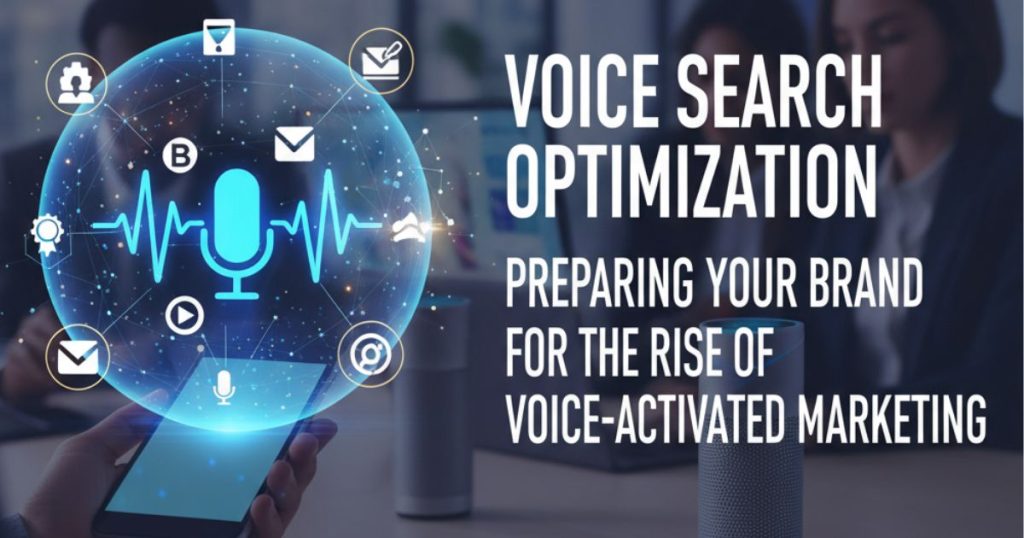Voice Search Optimization: Preparing Your Brand for the Rise of Voice-Activated Marketing

The way people search online is evolving rapidly. With voice assistants like Google Assistant, Amazon Alexa, and Apple Siri becoming integral to daily life, users are increasingly speaking their queries instead of typing. This trend has made Voice Search Optimization essential for brands aiming to stay visible and competitive in a voice-activated marketing landscape.
Unlike traditional SEO, voice search focuses on natural language processing (NLP), conversational search queries, and contextual relevance. Consumers often ask complete questions such as “Where is the nearest coffee shop?” or “Best smartphone for photography,” which means brands need to tailor their content to how people speak, not just type.
By implementing voice search strategies, optimizing for mobile and local SEO, and leveraging AI-powered search tools, brands can enhance customer engagement, improve digital visibility, and build trust and credibility in an increasingly voice-first world.
Understanding Voice Search and Voice-Activated Marketing

Voice search refers to queries made by speaking into a device rather than typing. Voice-activated marketing extends beyond search, encompassing any brand interaction initiated by voice commands—think personalized offers delivered via a smart speaker or audio-guided product demonstrations in-app. Both rely on natural language processing (NLP) and machine learning to interpret user intent and deliver relevant responses in real time.
The Rise of Voice Assistants
Major technology players like Amazon Alexa, Google Assistant, Apple Siri, and Microsoft Cortana have accelerated consumer adoption of voice interfaces. According to industry estimates, over half of all smartphone users now engage with voice assistants monthly. Smart speaker ownership has surpassed 200 million units globally, with more households adding dedicated voice devices every quarter.
Changing Consumer Behavior
Voice search behavior is markedly different from traditional text queries. Users tend to ask longer, more conversational questions (‘What’s the best vegan cafe near me?’) rather than typing short keyword strings. They also expect instant, concise answers. Brands must therefore rethink keyword strategy, content structure, and delivery format to align with voice-driven intent and UX expectations.
Why Voice Search Optimization Matters for Brands

Optimizing for voice search not only secures prime visibility on voice-enabled devices but also enhances overall SEO performance. Google’s algorithms increasingly reward pages optimized for featured snippets, mobile speed, and structured data—all critical components of voice-friendly content. Furthermore, as voice commerce grows, being discoverable via voice can translate directly into higher conversions and customer loyalty.
Key Strategies to Optimize for Voice Search
Leverage Long-Tail, Conversational Keywords
Identify and target question-based keywords that mirror how users speak. Tools like AnswerThePublic and SEMrush’s Keyword Magic can surface the most common voice queries in your niche. Structure your content to address these questions directly, using natural language and complete sentences to improve the chances of being selected for voice answers.
Create FAQ Pages and Structured Content
FAQ pages remain one of the most effective formats for voice search. Organize content into clear, question-and-answer pairs, with each answer kept concise (around 40–60 words) to match typical voice response lengths. Use header tags (
,
) to delineate questions, making it easier for search engines to extract and serve the relevant snippet.
Optimize for Local SEO
Voice searches frequently include local intent—‘near me’ queries or specific neighborhood references. Ensure your brand’s Google Business Profile is fully optimized with accurate NAP (Name, Address, Phone), business hours, high-quality images, and customer reviews. Incorporate local landmarks and service area mentions naturally within your website content to boost proximity signals.
Improve Page Speed and Mobile-Friendliness
Voice search users demand instantaneous answers. Slow-loading pages risk being bypassed by voice assistants in favor of faster sources. Implement core web vitals best practices: compress images, defer non-critical JavaScript, and leverage a content delivery network (CDN). Adopt a responsive design to ensure a seamless mobile experience—critical since most voice queries originate on smartphones.
Leverage Schema Markup
Structured data helps search engines understand your content contextually. Implement schema markup for FAQs, products, recipes, events, and local businesses. This increases the likelihood of your content being featured as a rich result or answer card, powering voice responses that drive users directly to your brand.
Integrating Conversational AI into Your Marketing Funnel

Beyond search optimization, conversational AI can enhance engagement at every stage of the funnel. Chatbots—text or voice—offer personalized recommendations, troubleshoot support issues, collect customer feedback, and facilitate seamless transactions without requiring human intervention.
Chatbots and Voice Bots
Deploy AI chatbots on your website and in messaging apps to capture and qualify leads 24/7. Complement these with voice bots on smart speakers and IVR systems, providing a unified omnichannel experience. Ensure your conversational flows are tightly scripted, using natural language prompts and fallback options to handle unexpected user queries gracefully.
Personalization and Data Collection
Conversational AI platforms can integrate with your CRM to deliver hyper-personalized experiences. Use customer data—purchase history, location, preferences—to tailor voice promotions and product suggestions. Respect privacy regulations by informing users when data is collected and offering opt-out choices.
Common Challenges and How to Overcome Them
Optimizing for voice search presents challenges: ambiguous user intent, limited analytics, and the evolving nature of voice algorithms. Address these by regularly auditing your conversational queries report in Google Search Console, A/B testing different answer lengths, and staying current with major voice platform updates.
Measuring Success: KPIs for Voice-Activated Marketing
Track KPIs such as voice search impression share, click-through rates on featured snippets, conversational engagement time, chatbot lead conversion rates, and voice commerce transactions. Use these metrics to refine your content strategy, dialogue flows, and promotional offers over time.
Future Trends in Voice-Activated Marketing
As AI and NLP technologies advance, we can expect more natural, context-aware voice interactions. Brands will leverage multimodal experiences—combining voice with visuals on smart displays—and tighter integration across IoT devices. Staying agile and data-driven will be key to capitalizing on the next wave of voice innovation.
Conclusion and Next Steps
Voice search optimization and voice-activated marketing are no longer optional—they are critical elements of a modern digital strategy. Start by auditing your existing content for conversational search intent, implementing structured data markup, and testing AI-powered chatbots on high-traffic pages. Combining these tactics with effective branding strategies ensures your business not only reaches customers but also strengthens brand credibility, customer engagement, and digital presence. Continuously monitor performance, refine content based on voice search analytics, and empower your brand to connect directly with audiences in the language they use every day—their own voice.





